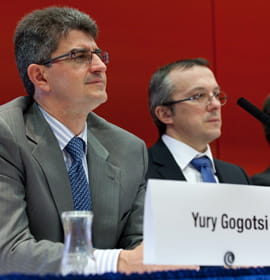Gogotsi Questions Battery Efficiency Metrics

- Drexel Environmental Collaboratory Releases Cross-Sector Findings on Severe Weather Recovery Challenges
- Drexel Launches the Manuel Stamatakis Center for Alternative Investments at the LeBow College of Business
- How and When Could AI Be Used in Emergency Medicine?
- Drexel Receives $1.4 Million Grant to Establish Hub for Literacy Reform

Solving the mystery of prematurely dead cell phone and laptop batteries may prove to be a vital step toward creating a sustainable energy grid according to Drexel researcher Dr. Yury Gogotsi. In a piece published in the November 18 edition of Science, Gogotsi, who is the head of the A.J. Drexel Nanotechnology Institute, calls for a new, standardized gauge of performance measurement for energy storage devices that are as small as those used in cell phones to as large as those used in the national energy grid.
Gogotsi is one of the featured experts, along with Bill Gates, tapped by Science to address problems that must be solved en route to the widespread use of renewable energy. His piece, co-authored with Dr. Patrice Simon of the Université Paul Sabatier in Toulouse, France, is entitled “True Performance Metrics in Electrochemical Energy Storage.”
“A dramatic expansion of research in the area of electrochemical energy storage has occurred over the past due to an ever increasing variety of handheld electronic devices that we all use,” Gogotsi said. “This has expanded use of electrical energy in transportation, and the need to store renewable energy efficiently at the grid level. This process has been accompanied by the chase for glory with the arrival of new materials and technologies that leads to unrealistic expectations for batteries and supercapacitors and may hurt the entire energy storage field.”
The main type of energy storage device addressed in the article is the supercapacitor. Supercapacators, which are built from relatively inexpensive natural materials such as carbon, aluminum and polymers, are found in devices, ranging from mobile phones and laptop batteries to trams, buses and solar cells. While supercapacitors tend to store less energy compared to standard lithium-ion batteries, they have the ability to charge and discharge energy more quickly than batteries and can be recharged a near infinite number of times, and operate in a wider temperature range with a high efficiency.
The main type of energy storage device addressed in the article is the supercapacitor. Supercapacators, which are built from relatively inexpensive natural materials such as carbon, aluminum and polymers, are found in devices, ranging from mobile phones and laptop batteries to trams, buses and solar cells. While supercapacitors tend to store less energy compared to standard lithium-ion batteries, they have the ability to charge and discharge energy more quickly than batteries and can be recharged a near infinite number of times, and operate in a wider temperature range with a high efficiency.
The issue that Gogotsi and Simon bring to light is the idea that current metrics for grading energy storage devices, including the Ragone plot, may not provide a complete picture of the devices’ capability. According to the researchers, other metrics, such as a device’s cycle lifetime, energy efficiency, self-discharge, temperature range of operation and cost, must also be reported.
“This paper calls upon the community of scientists and engineers who work on supercapacitors to present data on material performance using metrics beyond the traditional Ragone plot,” Simon said. “Although such plots are useful for comparing fully packaged commercial devices, they might predict unrealistic performance for packaged cells from extrapolation of small amounts of materials.”
Gogotsi and Simon have a longtime research collaboration, investigating materials for supercapacitors. Their joint work has received global coverage and various awards and distinctions. Funding for the collaboration between Gogotsi and Simon is sponsored by the Partner University Fund (PUF) which supports innovative and sustainable partnerships between French and US institutions of research and higher education.
In This Article
Contact
Drexel News is produced by
University Marketing and Communications.